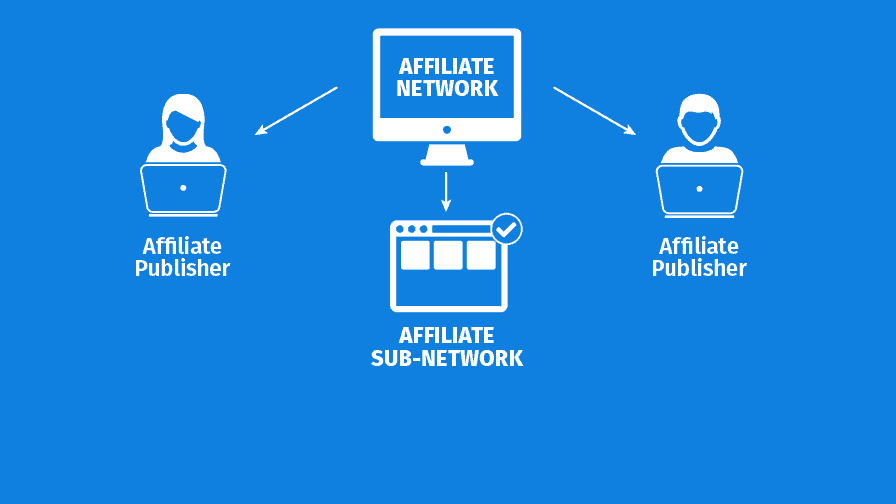What are sub-affiliate networks?
Sub-affiliate networks are a common feature in the affiliate marketing world. They offer services to publishers that can make it easier for them to monetise their website – they create a second tier of an affiliate programme – whereas a traditional affiliate network is a mediator between advertisers/merchants and affiliates/publishers. So, instead of trawling through all of the separate networks, a publisher can get it all in one place.
Acceleration Partners explains in a blog post that a sub-affiliate network signs up as an affiliate with a brand and bloggers, for example, joins the sub-affiliate network in order to promote that brand and gets paid commission. When the sub-affiliate network gets paid, they spread the payment to the sub-affiliate who drove those sales within their network.
What makes them valuable?
Sub-affiliate networks can drive significant traffic and maximise revenue for brands. They offer services that make it easier for publishers to monetise their content, promising high traffic and large conversion rates, as well as provide helpful tools that make it easier for sub-affiliates to promote brands. In addition, Acceleration Partners states that “by working with sub-affiliate networks, brands are able to share their offers with numerous small blogs and sites without having to have a direct relationship with them.”
Working with a sub-affiliate network can also provide value on a practical level, with Skimlinks’ website articulating that “earning money through traditional affiliate marketing can take a huge chunk of your day.” Many websites refer to Skimlinks as an example of a sub-affiliate network, however, there appears to be some confusion in the industry around what is classed as a sub-affiliate network. For instance, when we approached Skimlinks to comment on the topic, the company stated that it “would not describe themselves as a sub-network.” The vice president of marketing, Jean-Christophe Gombeaud later got in touch, stating that “the transparency we provide is important for Skimlinks, it is the reason why we do not see ourselves as a subnetwork. We are a transparent network of content publishers allowing advertisers to quickly scale their results from content.“
Interestingly, Sarah Bundy disagrees, specifying in a blog post that “the bottom line is Skimlinks IS, in fact, a sub-network and there are pros and cons to this.” We also reached out to VigLink but heard nothing back.
Although sub-affiliate networks can enhance affiliate programmes by maximising revenue, there have been some calls for more transparency to avoid fraudulent transactions. The lack of transparency between advertisers and their marketing partners has reached breaking point, with many advertisers now only working with those that are truly transparent in their practice.
Ensuring transparency
If looking to maximise revenue, cultivating transparency is something everyone should be working on as audiences now demand authentic, quality content. Brands can carry out various checks that indicate how transparent sub-affiliate networks on their programme are. It seems the future of affiliate marketing is based on authenticity and transparency, so it’s vital to do this in order to gain long-term, loyal customers.
In an industry that is data-focused, providing more information could only be a positive management step. The more data there is available, the better chance you have of fighting fraud. Paul Stewart head of publisher services and compliance at Awin said the three best ways to check if your sub-affiliate programme is truly transparent is to firstly “check referral URLs”. Most networks should allow this information to be passed back so you can see insightful data about where your traffic is coming from. Awin’s Stewart said, for example, a common issue can be passing HTTP traffic to HTTPS (or vice versa) and that said, “with a simple network link correction to ensure the same security protocol is being used you will see referral URLs starting to appear.”
Secondly, use “click references” to understand the origin of your traffic; there can be legitimate commercial sensitivity reasons for hashing this information (high-value influencer networks, for example, may do this) but in return should offer some level of visibility on request. Lastly, “split accounts” on networks to enable advertisers to choose what publisher type they want to work with.
“There are many checks and balances that can be put in place to ensure content is being displayed correctly, that only suitable websites are displaying – and monetising – advertiser content, and evergreen challenges such as brand bidding are swiftly dealt with,” said Owen Hancock, European head of strategy at CJ Affiliate by Conversant.
When something goes wrong
However, if a programme isn’t transparent, problems can arise. For example, vouchersea.co.uk was found to be listing fake vouchers for businesses, which presumably use affiliate networks for some of their listed businesses and just instead add fake ones to fill the website. This sort of action may put brands off joining an affiliate programme and giving sub-affiliate networks a bad reputation in the industry. But, how can we prevent (and solve) issues like this happening?
“If you have concerns that voucher code publisher’s via sub-affiliate networks are issuing fake codes then place more stringent guidelines in place with this account before accepting them on to your programme,” suggested Stewart.
“Instant detection and industry-wide blocking would remove the financial incentive for this type of behaviour,” added Stewart; “One of the larger sub-networks in the UK provide all their advertisers with access to a reporting dashboard that breaks down all activity on their programme – I’d like to see this standardised for all sub-networks.”
Viviana Viale, senior publisher development manager of EMEA at Acceleration Partners suggests that in order for advertisers to have control of the publishers they work with, they need to work in collaboration with sub-affiliate networks to ensure that all sub-affiliates who are promoting them adhere to their programme terms and conditions, “including restrictions on advertising through toolbars, browser extensions, and through any paid placements such as a pay-per-click campaigns.”
Hancock highlighted the importance of trust being at the heart of every affiliate relationship and added that “without proper transparency about what drives changes in performance – both positive and negative – then we’ll struggle to either maximise the lift, or minimise the drop.”
“The central point for overcoming these challenges will always be building a deeper and stronger relationship with the partner,” he said.
Trust can be fostered on both sides if the relationship between network and sub-affiliate network is developed over time.
“This allows the sub-affiliates to offer detail and transparency about performance and its drivers (both website and page) without fear that networks will approach those publishers directly,” continued Hancock.
Stewart agreed with Hancock’s statement, adding that “as with most partnerships, there are reputable long-term partners in the sector that will add value and there are newer or lesser-known ones that won’t have the compliance processes in place that give advertisers that reassurances that they need.”
“In order to build relationships, ensure you build a relationship with your sub-network – accepting and forgetting could result in unwanted partnerships and promotional activities becoming assumed to be accepted on your programme otherwise.”
Ultimately, brand control is vital to advertisers. A sustained breakdown in trust, especially when you cannot be confident the brand is being represented appropriately could lead to a whole sub-affiliate network being compromised and switched off.
Taking action
Some networks are taking the necessary steps to be as transparent as possible and Viale believes that advertisers should “work with sub-affiliate networks who will be willing to prevent sub-affiliates who have been removed from a client’s programme from being able to promote that client.”
Awin is a prime example of a network putting Viale’s words into action, as it invests heavily in compliance, and the sub-affiliate networks that operate via the company must reveal traffic sources to their compliance teams or face network-wide suspension. Awin maintains a ‘black-list’ that ensures publishers they’ve removed from their network can’t operate on their programmes via sub-affiliate networks.
“Many of our larger sub-networks also share real-time reporting with us that means we can instantly see who is active on a programme and proactively look to remove bad actors,” Stewart tells us; “If you have any concerns, flag these to your account manager who will have the compliance team investigate straight away. There has been significant progress from some of the larger sub-networks in this area over the last 12 months.”
In addition, Awin uses BrandVerity to monitor the search space and has a feed available that advertisers can use to issue valid codes to the channel. It also has a voucher attribution to allow code sales to be reallocated back to the original code owner, which helps reduce the commercial incentive to appropriate codes from those that have an exclusive.
On the other hand, CJ Affiliate’s Content Accuracy System screenshots offer content and codes, then generates an email to the publisher if the code is accurate. CJ, for example, has a 20-strong team devoted to maintaining network quality, which is further complemented by other technologies such as BrandVerity and PublisherDiscovery to maintain transparency and give the affiliate manager more control over the campaign.
Stewart thinks there is certainly space for an industry code of conduct in the future to standardise a lot of these practices.
When it comes to the bottom line, Hancock concluded that core affiliate networks will always bear responsibility for any affiliate that represents – or misrepresents – a brand, however, sub-affiliate networks themselves still have a vital role to play when it comes to compliance.
“Sub-networks, of course, need to be brave and offer deeper transparency on which of their partners are promoting which brands – normally achieved with a simple technological implementation – but we believe they also have a role to play in educating their affiliates about how to appropriately work with brands and best represent them,” said Hancock.


